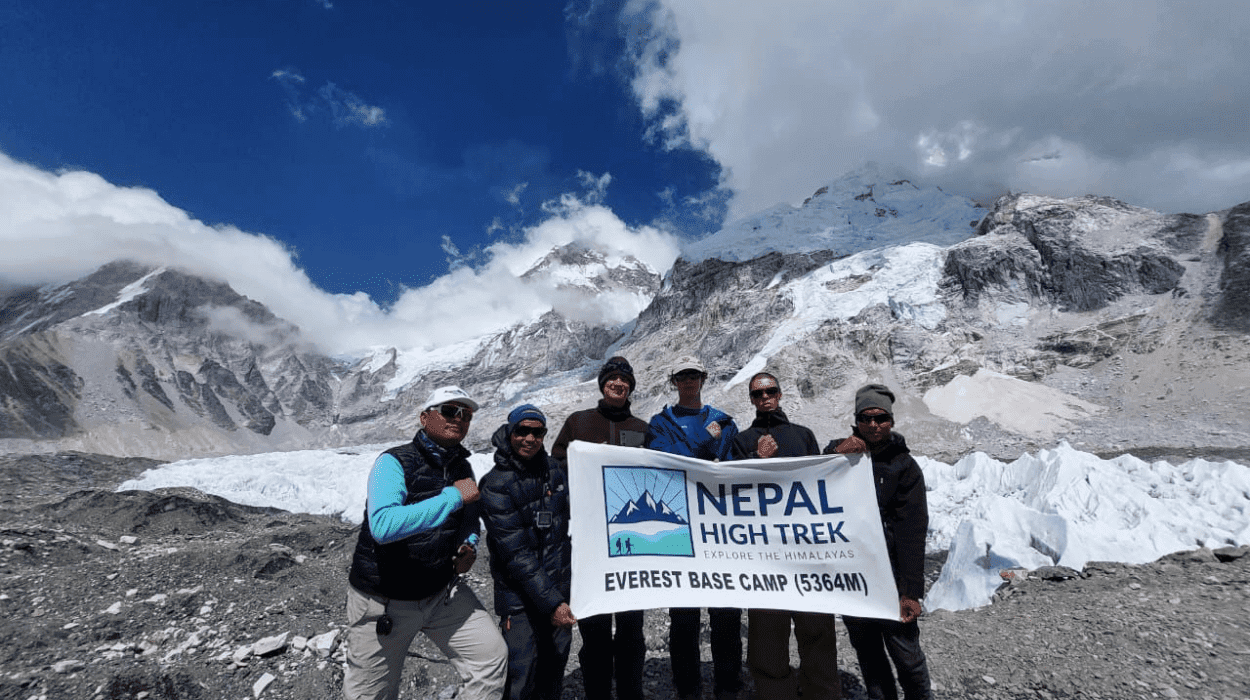The comparison between these two Himalayan ventures goes past unimportant height, diving into the subtleties of landscape, trek term, climatic conditions, and the special challenges each trek presents.In terms of the challenge posed to trekkers, Annapurna Base Camp trek requests more climbing involvement and cardio wellness due to its requesting landscape, which incorporates soak tough and downhill sections.On the other hand, whereas Everest Base Camp trek has a less requesting walk in terms of landscape, its essential challenge lies in acclimatizing to higher altitudes.
As we set out on this investigation, let’s dive into the one of a kind characteristics of the overwhelming magnificence of Annapurna and the grand charm of Everest.We will carefully explore through the personal characteristics that make each of these Himalayan mammoths a compelling and interesting goal, disclosing the complexities that set them separated on the canvas of normal wonders.
Altitude Ascendancy – The Great Elevation Showdown:
As the lean mountain envelopes both treks, the amazingness of Everest Base Camp gets to be apparent with its towering height of 5,364 meters, compared to the ‘lower’ height of Annapurna Base Camp at 4,130 meters.The contrast, be that as it may, is more than fair numerical; it’s a test of the human soul against the towering might of nature.
On the way to Everest Base Camp, trekkers confront both a physical challenge and a requirement to get utilized to the higher height. Climbing to more noteworthy status implies managing with less oxygen, turning each step into a test of human determination.The higher you go, the more your body fights with the more slender discuss, making each fruitful step a solid triumph against the intense powers of nature.
Contrastingly, Annapurna Base Camp, whereas arranged at a lower height, spreads out a diverse gauntlet for trekkers. The lower rise does not compare to a less demanding travel; or maybe, it presents a more forceful and saddling ascent.Trekkers are pushed into a domain of more extreme slants and decays, where the heart-pounding challenge lies not in the slenderness of the discussion but in the persistent requests set on cardiovascular endurance.
Each walk gets to be a conclusive arrangement with the undulating landscape, pushing the limits of physical strength to the brink.In this extraordinary rise standoff of Everest Base Camp trek vs Annapurna Base Camp trek, trekkers discover themselves at the crossing point of elevation and adversity.
Trek Distance and Duration – The Marathon and the Sprint:
In the trek for base camp radiance, time gets to be an essential figure. Everest Base Camp, settled in the heart of Sagarmatha National Stop, with its longer endeavor crossing roughly 130 kilometers over 12-14 days, feels like a marathon, an perseverance test where trekkers are required to maintain their physical and mental ability over an extended period.
The longer term not as it were included to the physical challenge but moreover tests the trekkers’ mental resilience.
On the flip side, Annapurna Base Camp, set in the midst of the captivating scene of the Annapurna Preservation Zone, is the sprinter’s challenge. A 10-12 day trek covering around 105 kilometers requests a diverse kind of stamina – a burst of vitality and commitment. Trekkers must be arranged to confront a condensed but strong travel, with each day displaying an unused jump to cross.
The Terrains – Annapurna’s Steep Symphony and Everest’s Altitude Ballet
To genuinely comprehend the veering challenges of these treks, one must look at the complexities of the territories. Everest Base Camp, known for its ‘staircase to the sky,’ offers a generally less requesting walk in terms of terrain.
The well-trodden ways and smoother climbs are misleading, covering up the essential challenge – acclimatizing to the higher elevations. Trekkers must learn to waltz with the diminishing discus, a move that requires elegance and patience.
In stark contrast, Annapurna Base Camp divulges a soak ensemble. The trek requests a more significant climbing encounter and cardio wellness due to its challenging terrain.
Trekkers are pushed into a world of soak tough fights and knee-jarring plummets, pushing the boundaries of physical continuance. Each step is a confirmation to the versatility of the human body against the impressive constraints of nature.
While the rising to Everest Base Camp unfurls like a expressive dance at height, where trekkers nimbly adjust to the changing discussion weight, the trip to Annapurna Base Camp changes into an ensemble of soak slants and descents.
The Weather Elements – Annapurna’s Rain and Everest’s Cold
Both the Annapurna Base Camp and Everest Base Camp treks display particular and tireless climate challenges all through the year, contributing to the special character of each trek.
As we dive into the climatic conditions, the treks uncover another layer of their particular identities. Annapurna Base Camp, settled in the heart of the Himalayas, faces a reliable challenge with overwhelming precipitation, especially amid the storm season that changes the trek into an elusive, sloppy ballet.
Trekkers must explore not as it were challenging territory but too the unusual and tenacious storm, including a wild, unusual component to the trek.
In contrast, Everest Base Camp presents a bone chilling challenge stamped by reliably cold temperatures and intermittent cruel climate conditions at higher elevations make an frosty expressive dance, where trekkers must fight with solidifying winds and desensitizing cold.
The fight against nature amplifies past the physical climb, making a continuous test of strength against the unforgiving elements.
Determining which trek is ideal depends on personal inclinations and the sort of encounter one looks for. Annapurna Base Camp offers an energetic move with the rain, requesting dexterity and versatility, whereas Everest Base Camp presents a steady frigid execution that challenges endurance.
The Human Element – Personal Perceptions and Varied Experiences
In the huge picture of these treks, no two strings are alike. Individual encounters and challenges have become the special brushstrokes that paint the canvas of each trekker’s trek.
While a few may discover the height of Everest more overwhelming, others might see Annapurna’s landscape and shorter term as more challenging.
Interviews with prepared trekkers and guides uncover the differing points of view that enhance the story. One trekker might describe the invigorating battle against Everest’s lean discuss, whereas another might share the story of prevailing Annapurna’s tenacious inclines.
The Cultural Tapestry – Annapurna’s Villages and Everest’s Sherpa Legacy
Beyond the physical challenges, both treks offer a wealthy social involvement, including however another layer to the comparison. Annapurna Base Camp presents trekkers to charming neighborhood towns, each with its own special traditions and traditions.
The assorted ethnic communities, counting the wealthy Gurung and Magar societies found generally along the path give a glimpse into the social mosaic of the locale. Connection with the local people and drenching oneself in the dynamic embroidered artwork of Annapurna’s towns gets to be a fundamental portion of the trek.
On the opposite, Everest Base Camp reveals the Sherpa bequest. The path is embellished with cloisters, supplication banners, and the warm neighborliness of the Sherpa people.
Trekkers have the opportunity to witness the one of a kind mix of Tibetan Buddhism and nearby Sherpa traditions. The social inundation at Everest goes past the physical travel, advertising a significant association with the otherworldly and social legacy of the region.
The Wildlife Symphony – Annapurna’s Biodiversity and Everest’s Mountain Fauna
As we wander into the comparison, the biodiversity of Annapurna Base Camp stands out. The rich timberlands along the path are overflowing with different greenery and fauna.Trekkers might experience an assortment of feathered creature species, dynamic rhododendron blossoms, and indeed the slippery snow panther. The trek gets to be a tactile encounter, with the sounds of stirring takes off and winged creature calls going with the trek.
Contrastingly, Everest Base Camp offers a see into the unforgiving however captivating mountain fauna. The locale is home to the tricky Himalayan Tahr, ruddy pandas, and the grand brilliant eagle.The stark magnificence of the desolate scenes at higher elevations makes a dreamlike scenery for these uncommon experiences. Each step towards Everest is not a fair climb in elevation but a trip through the special biodiversity of the Himalayas.
Choosing Your Himalayan Odyssey with Nepal High Trek:
Nepal High trek also gives you a short trek of 7 days Annapurna base camp trek which takes you to all the major attractions – but in less time than other treks to the Annapurna region. Take in the spectacular soaring snow-capped peaks, unique Gurung culture & villages, and amazing landscapes.
As we unwind the complexities of Annapurna and Everest Base Camp treks, the wrangle about which is more challenging gets to be an ensemble of choices.
Ultimately, the issue of whether Annapurna Base Camp is harder than Everest Base Camp is as slippery as the Himalayan fog. The treks are not fair physical challenges; they are soul-stirring odysseys that unwind the most profound layers of human resilience.
The choice between Annapurna and Everest is not a matter of one being prevalent to the other; it’s a reflection of personal yearnings, qualities, and the longing for adventure.
As you stand at the junction, mulling over your Himalayan enterprise, keep in mind that both Annapurna Base Camp and Everest Base Camps call with their interesting allure.
FAQS
How long is the Everest Base Camp Trek?
The Everest Base Camp trek regularly takes around 12-16 days, depending on the course and acclimatization needs.
What is the highest point reached on the Everest Base Camp Trek?
The highest point on this trek is at Everest Base Camp itself, which is at an altitude of about 5,364 meters (17,598 feet).
How long is the Annapurna Base Camp Trek?
The Annapurna Base Camp trek ordinarily takes around 7-12 days, depending on your pace and acclimatization
Contact to Nepal High Trek
Nepal High Trek And Expedition Pvt. Ltd. is an authentic local trekking company based in Kathmandu, Nepal, specializing in multi-day tours, treks, climbing and other related activities for solo travelers and private groups. You can contact us at info@nepalhightre.com or via WhatsApp at +977-9851142116.







